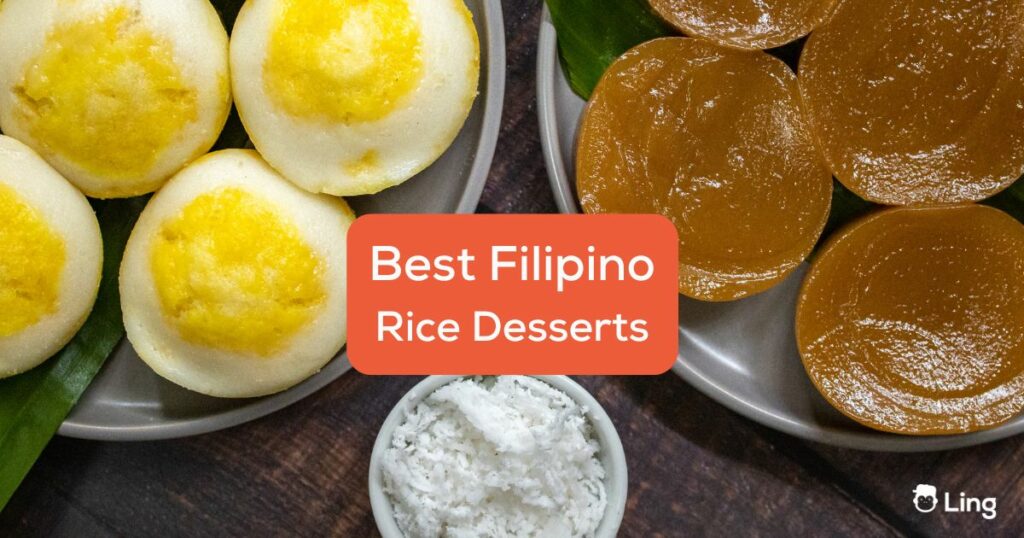In the Philippines, we love our rice, but we turn it into some seriously mind-blowing Filipino rice desserts! They’re chewy, coconut-infused bites that melt in your mouth, steamed treats wrapped in banana leaves, and layers of colorful goodness so pretty you almost don’t want to eat them (but trust me, you will!).
I grew up with these sweets at every celebration and every visit to grandma’s house. Now, I’m ready to share all the best ones with you. Whether you’re craving a taste of Filipino culture or just something to cure that sweet tooth, I’ve got you covered and will help you learn Tagalog words, too. Let’s explore these popular rice desserts in the Philippines together!
Table Of Contents
What Are Rice Desserts In The Philippines?
The Tagalog term for Filipino rice desserts is kakanin, which comes from the words kain (to eat) and kanin (cooked rice). These aren’t your average sweets; they’re a taste of Filipino history, a celebration of sticky rice, coconutty goodness, and a serious dose of tropical sweetness.
So, What’s The Secret Formula?
Filipino rice dessert recipes often start with the variety of rice in Tagalog called malagkit, or glutinous rice in English. We add creamy gata ng niyog (coconut milk), the right amount of sweetness (often a touch of brown sugar), and sometimes a sneaky hint of fermented rice called tapay for that extra flavor kick.
Where’d They Come From?
As I’ve said, we Filipinos are seriously in love with rice. We even have stories about it in our old myths! No wonder we came up with so many creative ways to turn rice into the ultimate sweet treat.
Then the Spanish swung by in 1521 and brought cool stuff like coconut milk and sugar, which we were all about adding to the mix. Now, each region in the Philippines has its own take on the rice dessert, influenced by what grows locally.
10 Popular Filipino Rice Desserts
These sweet sticky rice treats are about to rock your world with flavors that make you go “Woah!”, textures that keep you guessing, and vibrant colors that’ll make your Instagram feed pop. Let’s explore the world of Filipino rice desserts—I dare you not to find a new favorite!
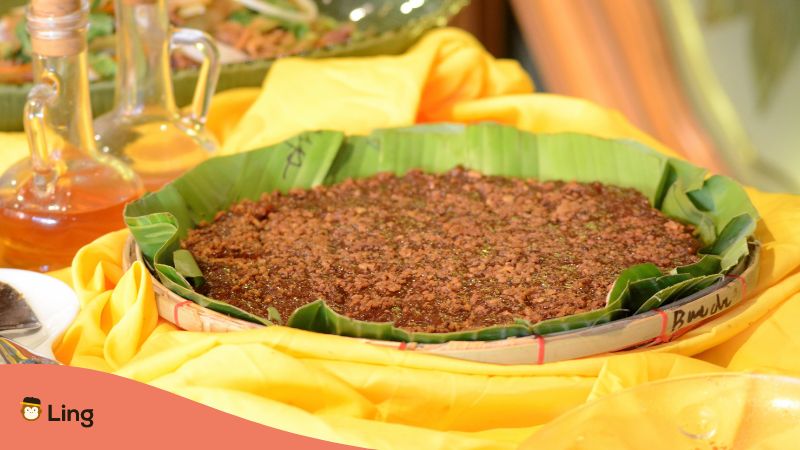
1. Biko
Biko is a crowd-pleaser everywhere at Filipino celebrations, from birthdays to town fiestas, and for good reason. It’s basically a sticky, sweet hug in dessert form, symbolizing how close-knit Filipino families are – just like all those glutinous rice grains clinging together!
Made with malagkit, our super-sticky rice, biko is like magic. First, the rice gets a quick steam. Then, it takes a dip in coconut caramel milk and dark brown sugar, getting stirred until it reaches a thick, gloriously sticky consistency.
In the Visayas and certain parts of Southern Luzon, biko is sometimes called kalamay and made softer, almost spreadable. Some regions in the Philippines love adding a delightful crunch with grated mature coconut or a drizzle of latik—the leftover goodness after frying coconut milk. To ensure everyone gets a taste, biko is served on a giant bilao, a round bamboo tray lined with banana leaves.
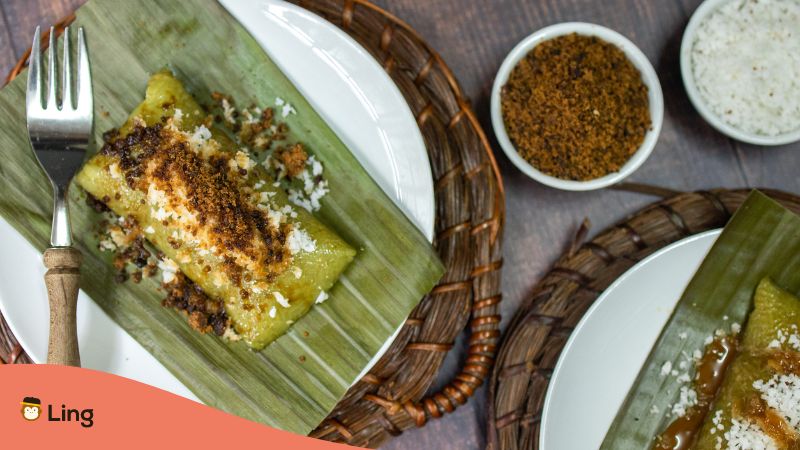
2. Suman
Suman is the ultimate proof that Filipinos can turn anything into a delicious dessert with over a dozen types. Each region has its own spin on this delightful Filipino sticky rice cake.
Suman’s history goes way back, even before the Spanish arrived. Back then, it was even used as an offering in pre-Hispanic religious rituals! Now, it’s a beloved part of Filipino food culture, enjoyed all year round.
In the Oriental Mindoro province, suman sa lihiya is a superstar where glutinous rice gets treated with a special lye bath for a unique taste, then wrapped in fragrant banana leaves. Meanwhile, in the Ilocos region, suman sa ibus steals the show. Here, they use coconut leaves to steam the glutinous rice into cool cylindrical shapes.
In Bicol, the coconut milk is like a flavor party, while in Laguna, suman sa ibus showcases the region’s amazing craftsmanship with intricate palm leaf wrapping. And the best part? Suman goes perfectly with ripe mangoes and hot chocolate, especially during Christmas.
The prep process is pretty cool: The glutinous rice sleeps over in water overnight and wakes up to a mix of coconut milk and a pinch of salt. Each region then gets creative with the wrapping, using local favorites like banana leaves, coconut leaves, or even palm leaves, depending on what grows nearby. Finally, they steam it all to perfection, creating a delicious and versatile treat.
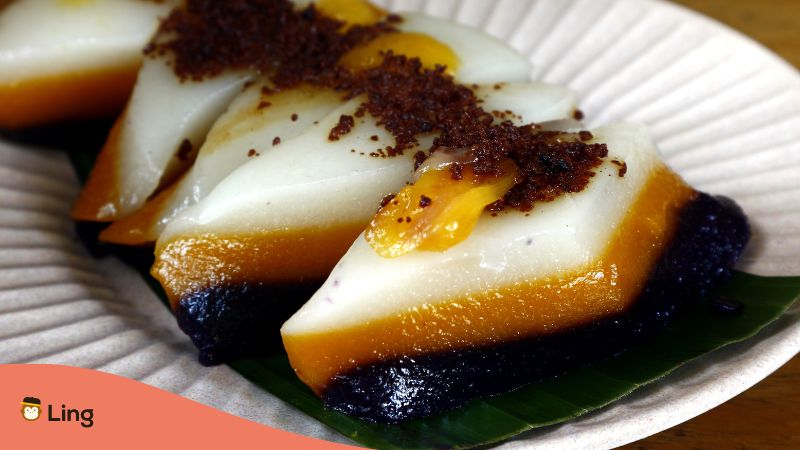
3. Sapin-Sapin
Sapin-sapin, meaning “layers” in Filipino, is a true testament to its name. Think layers of sweet and sticky rice flour dough, made extra creamy with coconut milk and a splash of natural flavors.
Ube (purple yam) creates a gorgeous violet layer, while langka (jackfruit) adds a vibrant yellow. For a pop of green, pandan, with its subtle, almost vanilla-like flavor, is often used.
They don’t just slap it together – each layer is steamed one by one, creating a stunning dessert that’s just as fun to look at as it is to eat! And to top it all off (literally!), it usually gets a generous sprinkle of latik, just like with the biko recipe.
But here’s where I get excited: sapin-sapin represents the mix of Malay, Spanish, and indigenous influences that make up Filipino culture. So when we break this out for fiestas, birthdays, and any time we need an excuse to celebrate, it’s a celebration of being Filipino!
Want to taste the very best sapin-sapin? Head to Northern Luzon, where families have been perfecting their recipes for generations!
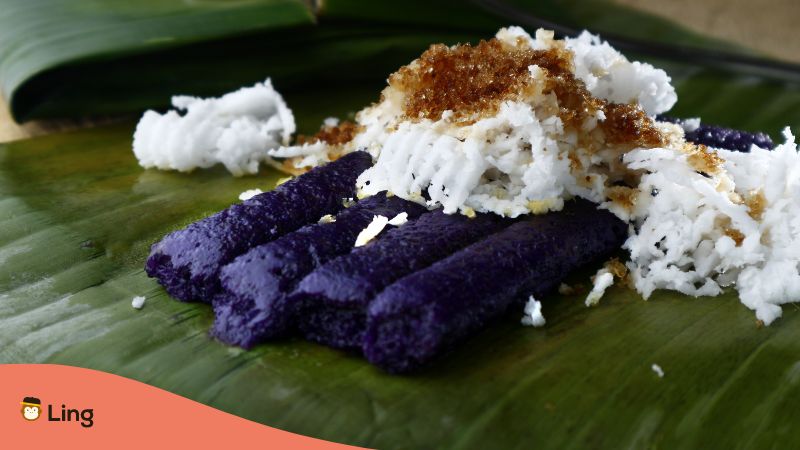
4. Puto Bumbong
Fact: Christmas in the Philippines wouldn’t be the same without puto bumbong! This vibrant purple dessert, a favorite in the Tagalog region, is practically a symbol of Simbang Gabi, those early morning masses leading up to Christmas.
Puto bumbong gets its name from the special bamboo tubes called bumbong that are used for steaming. But the real star is the rice—puto bumbong uses a special type of sticky rice called pirurutong that’s a gorgeous dark purple color.
And this is the fun part: traditionally, they actually set up steaming stations right outside the church after mass! So you can get it fresh and hot, perfect for warming you up on those chilly mornings.
Straight out of the tube, puto bumbong gets a brush of melted butter or margarine, a sprinkle of grated coconut for texture, and a generous dusting of muscovado sugar for sweetness. And if you’re feeling extra festive, some folks even like to drizzle a bit of condensed milk on top for next-level deliciousness.
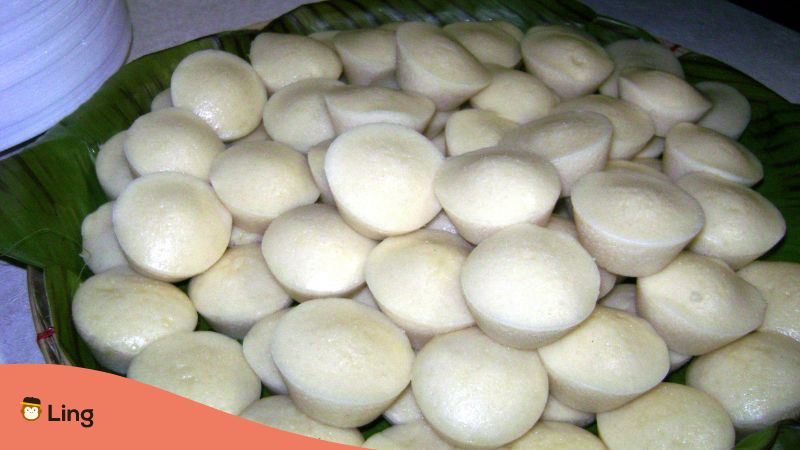
5. Puto
Puto is the OG of Filipino rice desserts. Like the Filipino dessert suman, puto was used as an offering during pre-Hispanic rituals! Over the centuries, puto has seriously leveled up and is now a favorite breakfast for Pinoys.
Calasiao, Pangasinan, is known for its Puto Calasiao, a bite-sized version with a unique, slightly tangy flavor from the fermentation process. Craving something cheesy? Puto Cheese is your new obsession – it’s exactly what it sounds like, with a slice of cheddar on top! Or, if you’re into pretty desserts, try Puto Pandan, which has a bright green color and a gentle sweetness from the pandan leaves.
The basics of puto haven’t changed much. Traditionally, they soak ground rice (a specific type of rice called galapong) overnight, mix it with sugar and coconut milk, then steam it to fluffy perfection.
Modern shortcuts use rice flour for convenience. And, depending on the region, fermentation plays a part in giving puto its unique texture and flavor!
Puto is a staple at Filipino celebrations, from birthdays to meriendas (that’s our word for a Filipino snack break!). We love it with savory dishes like dinuguan (pork blood stew), which highlights its versatility.

6. Kutsinta
Kutsinta might look a little strange at first—its bright orange or brown color and jelly-like texture can be intimidating. But this is one dessert where you gotta ditch your doubts and just dive in!
The secret’s in the lye water, which is where the color and that signature chewiness come from. Kutsinta has been a go-to merienda for ages, perfect with a steaming cup of coffee.
The main Tagalog ingredients for kutsinta are rice flour, brown sugar, and that magic lye water, but sometimes, they’ll toss in annatto seeds to make the color even brighter. After mixing it all up, it gets steamed until it’s set.
Kutsinta is all about that combo of grated coconut on top and the slightly sweet, slightly salty flavor of the cake itself. It’s surprisingly good paired with both sweet and savory dishes, which is just another reason Filipinos love it so much!
You’ll find kutsinta all over the Philippines, but there are some regional variations. Some recipes call for cassava flour to add a denser, more satisfying bite.
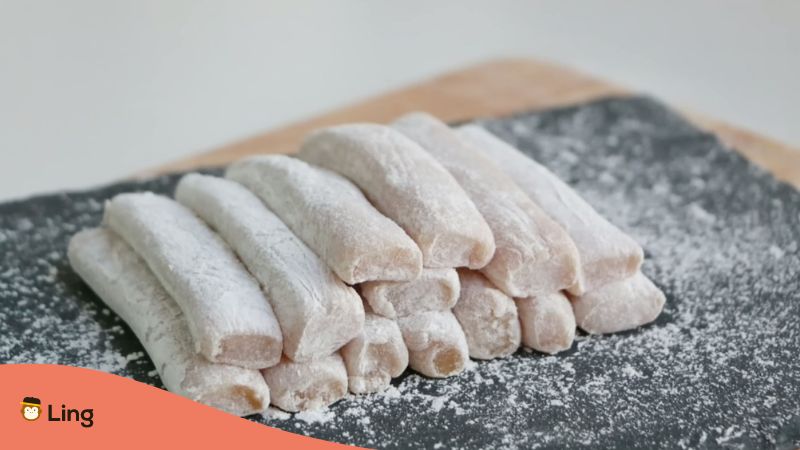
7. Espasol
Ever seen those little cylinder-shaped rice cakes covered in white powdery stuff? That’s espasol, a classic Filipino dessert that originally hails from Laguna province.
This sweet rice cake gets its name from the Spanish word polvo, which means powder or dust. This is super fitting because those things are coated in toasted rice flour! At its core, it’s made from glutinous rice and coconut milk, sweetened with sugar, and then rolled into cute little logs.
You might find espasol at local festivals or as a delicious homemade gift during the holidays. It’s one of those things we love to bring back as pasalubong (souvenirs!) for friends and family.
The tricky part with espasol is getting the texture just right – it needs to be sticky enough to hold its shape but not too dense or it won’t be fun to eat! Sometimes, you’ll find versions with different flavors like ube or pandan because we Filipinos love putting our own spin on the classics.
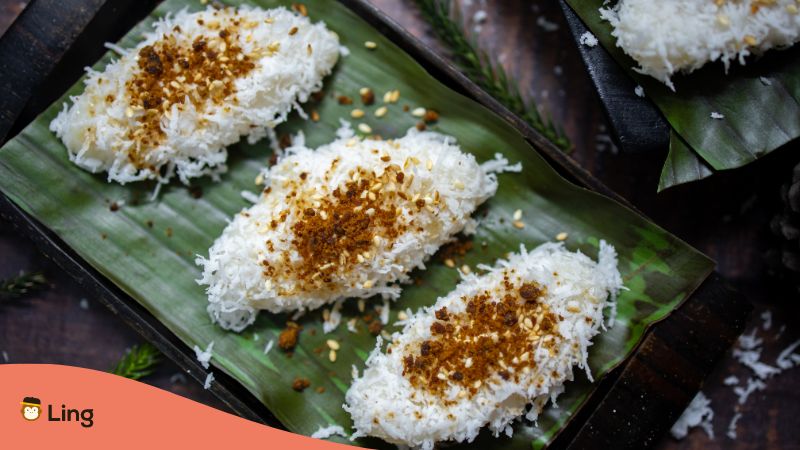
8. Palitaw
Sometimes, the simplest things are the most delicious! Palitaw is exactly that: just a little disc of chewy rice dough that floats to the top of the pot when it’s cooked.
The name palitaw literally means “to float” or “to surface” in Tagalog, which could not be more perfect for this treat! To make palitaw, you mix glutinous rice flour with a bit of water, roll it into flat little circles, and drop them into boiling water.
Once those little discs float, they get rolled in a mix of grated coconut, sugar, and toasted sesame seeds. That combo of chewy Filipino rice cake, sweet coconut, and the nutty flavor of those sesame seeds is seriously addictive!
Palitaw is often served during special occasions like New Year’s Eve because it’s a symbol of hope and good luck. But honestly, you don’t need a special reason to make it! You’ll find palitaw sold by street vendors and at local markets all year round.
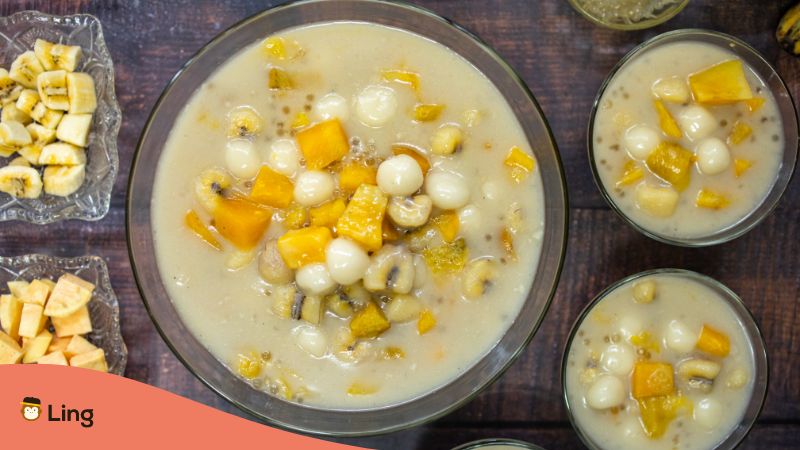
9. Ginataang Bilo-Bilo
The ginataang bilo-bilo is a warm, soupy treat staple in Filipino snack time. Imagine chewy little balls of rice flour (those are called bilo-bilo), chunks of sweet potato, taro (which we call gabi), slices of saba banana, and jackfruit, all swimming in sweet coconut milk.
Making ginataang bilo-bilo takes a bit of patience, but it’s so worth it. You gotta mix your glutinous rice flour and roll it into tiny balls. After that, you cook everything low and slow, stirring constantly so it doesn’t stick, until the whole thing is thick and creamy.
Ginataang bilo-bilo is best served hot, especially on a chilly day. Some people (including me!) like to add sago (tapioca pearls) or chunks of ube. We often make this Filipino rice dessert during Lent and other religious celebrations when we want something hearty but meat-free.
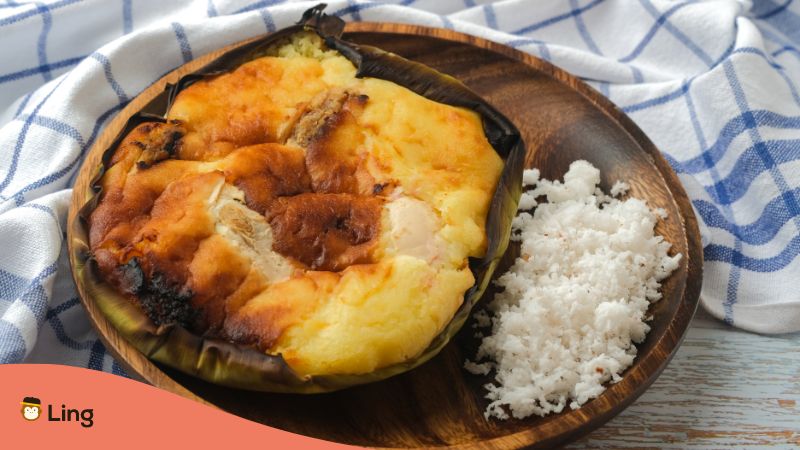
10. Bibingka
Bibingka, this baked rice cake goes way, way back, even before ovens arrived. This Filipino rice dessert is cooked in clay pots as a baking dish lined with banana leaves over hot coals, which is where it gets that slightly smoky flavor!
The classic batter is made with a mix of glutinous rice flour, coconut milk, eggs, and some sugar. And those banana leaves? Aside from giving that smokiness to bibingka, it also gives the whole thing a subtle, vanilla-like flavor.
You’ll see itlog na maalat (salted duck eggs), kesong puti (white cheese), and grated coconut as popular toppings. Some have slices of ripe mango or a swirl of ube halaya (purple yam pudding)!
In areas like the Visayas and Mindanao, some recipes even use cassava or millet flour instead of rice flour. There’s even gourmet bibingka these days, with chorizo and chocolate.
The Sweet Wrap-Up
After this sweet trip, one thing’s for sure: Filipino rice desserts are way more than simply a sugar high! Think chewy textures, tropical flavors, and bursts of color that’ll make your taste buds sing.
These treats are a delicious reflection of our history, our love for celebration, and a whole lot of Filipino creativity that turns sticky rice into a truly satisfying dessert. If you’re ready to ditch the usual desserts, Filipino rice desserts are here to shake things up!
